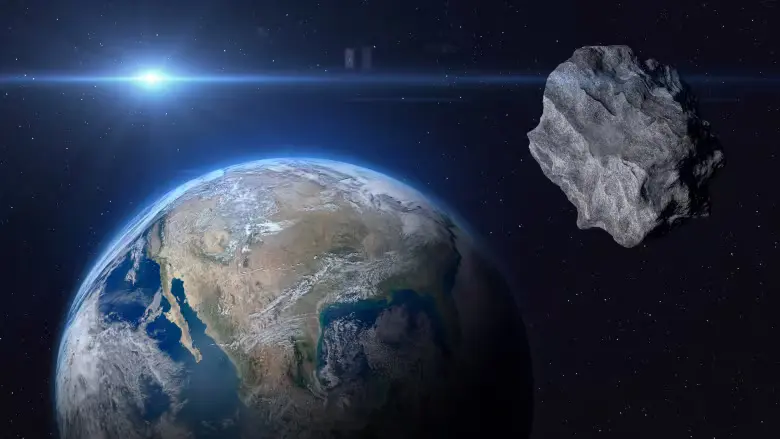The Earth is encompassed by entities and fragments of matter that remain from the creation of the system around 4.5 billion years ago. These cosmic entities, varying from particles, to asteroids frequently wander close to our planet. This Saturday a particular rocky leftover known as 2024 MK will have a near encounter, with Earth.
The Asteroid: 2024 MK
Asteroid 2024 MK is expected to pass by Earth at a distance of 290,000 km which’s about 75% of the distance, to the Moon. While smaller asteroids often fly past without notice 2024 MK stands out due to its size, estimated to have a diameter ranging from 120 to 260 meters.
Peter Brown, a Canada Research Chair in meteor astronomy and a professor at Western University in London Ontario pointed out the aspect of discovering this asteroid; “One key takeaway here is that it’s quite an object and it was only spotted 10 or 12 days before its closest approach. The time we saw an object of size or larger come this close to Earth was back, in 2001.” Brown’s remarks emphasize the rarity and importance of this occurrence.
Alan Fitzsimmons, a scientist specializing in planets, at Queens University Belfast mentioned that 2024 MK will be observable from the hemisphere at its position. The evening it will appear in the Scorpius constellation situated low in the skies of Canada. Nonetheless observing it necessitates a position and a quality telescope since it won’t be discernible, to the eye.
The Potential Impact
Thankfully the year 2024 asteroid MK is not a danger, to Earth. Still the idea of an impact is quite sobering. “This object is substantial. With its size it could unleash an impact energy to hundreds of megatons nearing a gigaton ” Brown elaborated. Such an impact would bring about destruction possibly impacting areas of the eastern United States though it wouldn’t be severe enough to affect the entire planet.
Asteroid Awareness and Preparedness
The timing of the 2024 MKs flyby holds significance. Over a week ago NASA published a report, on a simulation regarding asteroid threats that took place in April. Additionally the flyby is set to occur one day before Asteroid Day, which is observed every year on June 30. This global event, endorsed by the United Nations was established in 2014 by astrophysicist and former Queen guitarist Brian May alongside Apollo 9 astronaut Rusty Schweickart and others. Its main goal is to educate the public, about asteroids and their potential dangers while advocating for enhanced asteroid detection initiatives.
Numerous sky observations, like the Asteroid Terrestrial impact Alert System (ATLAS) are always on the lookout for asteroids that could pose a threat to us. Recently ATLAS found 2024 MK. Fitzsimmons highlighted that there is typically a 10 meter asteroid, between Earth and the Moon at any moment. Earth regularly encounters space debris leading to meteors disintegrating in our atmosphere every day.
Historical Reminders and Modern Efforts
In 1994 the world saw the looming danger of space when fragments from a comet crashed into Jupiter. This threat was reinforced in 2013 when a 20 meter rock burst over Chelyabinsk, Russia causing injuries, to 1,000 individuals. These incidents stand as reminders of how fragile our planet can be.
Asteroid Day highlights the aspect that sets asteroid impacts apart, from natural disasters. They can potentially be averted. Fitzsimmons pointed out “It’s the disaster within our control. Tsunamis earthquakes and volcanoes are, beyond our ability to prevent. However in theory we can intervene to prevent an asteroid collision.”
NASAs DART mission, in 2021 showed how we can redirect asteroids and now the European Space Agencys Hera mission, set to launch in October will delve deeper into these findings.
Future Encounters
NASAs OSIRIS REx mission, which brought back a sample from the asteroid Bennu in 2023 has now been given a task named OSIRIS APEX. This spacecraft is set to explore the known asteroid Apophis. Initially considered a threat, to Earth in 2068 Apophis is scheduled to make a close pass by Earth in 2029 coming within the orbit of geostationary satellites at around 30,000 km.
The upcoming flyby of 2024 MK sets the stage for asteroid events in the near future. According to Peter Brown “The anticipated event is Apophis in April 2029. It’s an occurrence that happens once in a millennium. There hasn’t been anything large as this in recorded history. Additionally there’s another asteroid known as 2001 WN5 that will come than 2024 MK. It’s massive measuring about a kilometer, in size.”
Conclusion
The imminent arrival of 2024 MK highlights the significance of identifying and getting ready, for asteroids. As space organizations, like NASA work hard to document Hazardous Asteroids (PHAs) staying alert and educating the public are essential. On Asteroid Day we are reminded that taking steps and leveraging progress can safeguard our world against potential asteroid hazards
Affiliate Suggestions
If you’re keen, on delving into the realm of asteroids and cosmic events you might want to check out these recommended items;
- Beginner Friendly Telescopes; Embark on your stargazing adventure with telescopes designed for use ideal for observing distant celestial bodies. Discover top telescope picks here.
- Books on Asteroids and Meteors; Immerse yourself in the world of asteroids through reads by renowned astronomers. Explore a curated selection of recommended books
- Educational Kits for Youngsters; Spark interest in astronomy among kids with educational space kits tailored for minds. Take a look at the options.
- Gear, for Astrophotography; Capture breathtaking images of the night sky using quality astrophotography equipment. Check out gear options to elevate your photography experience.
These resources can enrich your knowledge and admiration for the universe that surrounds us.


